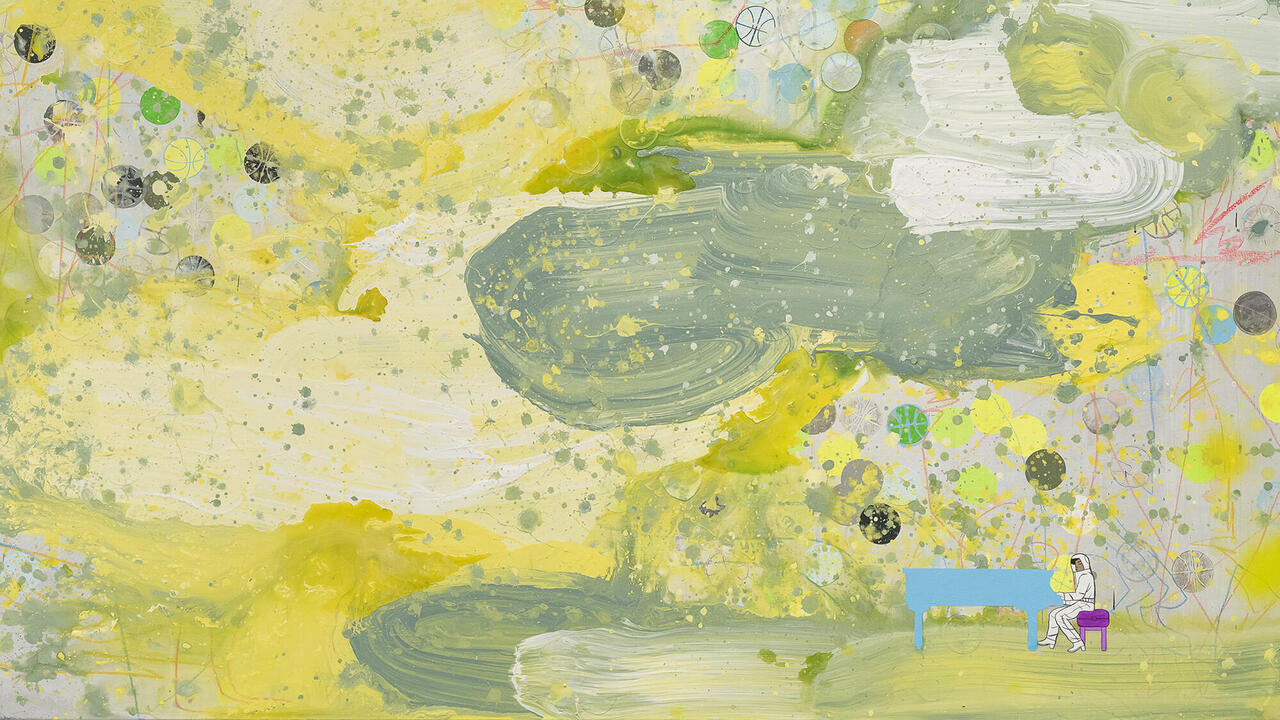Six Nights of Studies in Sub-History Light
Galerie Sabine Knust
Galerie Sabine Knust

‘Hey, look at the facts’ it said, handwritten in white on a black poster. This was folded into an invitation card for the exhibition Six Nights of Studies in Sub-History Light curated by artist Andy Hope 1930. A sketched schema on the poster mapped the ‘components’ of the exhibition like a genealogical tree, each participating artist connected by arrows, descriptions and biographical associations. Serbian painter, poet and fashion designer, Milena Pavlovi´c-Barili (1909–45), who before her untimely death in New York studied under Franz von Stuck in Munich in the late 1920s, is described as ‘a kind of a Super-girl’. Next to her, we see that Hans Baschang (born 1937) was a professor to Stephan Dillemuth who ‘creates timeless pictures and settings for insiders, expert in birdcalls/society of control’. Ben Kaufmann is mentioned as ‘gallerist, director of art space, and artist, good guy’ and last but not least Andy Hope 1930 himself, who ‘can fly to different places in time’. But this imperative to ‘look at the facts’ was a red herring. Andy Hope 1930 is the artist alter ego of Andreas Hofer and the associative connections on the poster hinted to a logic beyond empirical truths that links the works together.
Dillemuth’s humorous Redundanz (2012) confronted you upon entering the gallery: two rotating cogs bearing two taxidermied goats. One is perched on a monitor with a video feedback system that alternates between broadcasting and filming the show. Two of Utz Kampmann’s abstract Plexiglas sculptures from 1970 face Dillemuth’s goats like guards. The tower-like constructions were made from transparent office utensils, piled high to form minimalist sculptural blocks. They appear here as dusty as they were found (by Hope at Baschang’s home). As with Baschang, Kampmann’s inclusion added a resonance of high Modernism that was here remixed with a ‘twist’.
In the back space one could see Dillemuth’s three ironic variations on Matisse’s Blue Nudes, Selbstportrait als blauer Akt I–III, (Self Portrait as Blue Nude No. I–III, 2007) and print copies of Pavlovi´c-Barili’s paintings (the originals were unavailable). Among them, a portrait of the Hollywood dandy Rudolph Valentino (1927) in a Lawrence of Arabia outfit as well as paintings of neo-classical statues (bringing to mind De Chirico who studied in Munich around 15 years before the artist). Ruins, seascapes and other Romantic tropes featured in other paintings nearby. Importantly, the dates of those, 1933, corresponded with Hope’s signature that repeatedly refers to the crucial decade-of-no-return in German history. A small gouache painting by Hope was a typically appropriative homage to Pavlovi´c-Barili, transforming her into one of Hope’s super heroines dressed in a Roman-inspired outfit.
The pairing of seemingly unsuitable works – infecting the abstract with the figurative – recurred with the placement of Speak our names (2013) by Hope next to a large abstract drawing by Baschang. The indigo silhouettes of two oddly-sized cowboys holding hands in Hope’s large painting were mirrored in Baschang’s spiky lines: geometrical structures that flicker into fragments of two figures swirling into a whirlpool.
As well as typical elements from Hope’s artistic universe, personas and art works from various times were entangled through their presence in the city of Munich and its academy. It was this genealogical pivot that Andy Hope’s 1930’s idiosyncratic, pedagogical exhibition hinged upon.
















